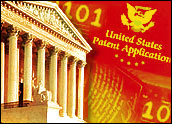
In what one attorney described as “the most important patent case in a generation,” the U.S. Supreme Court on Monday issued a decision that’s expected to make patents that combine existing technologies more difficult to obtain.
“What this case will do will make it harder to get patents in the first place because it will ease the restrictions on the [U.S.] Patent Office for rejecting patents for obviousness, and it will make them easier to challenge in court,” Philip Swain, an adjunct professor at Suffolk University Law School in Boston and a partner at Foley Hoag, told the E-Commerce Times.
The facts in the case before the court, KSI International v. Teleflex, deal with accelerator pedal technology in automobiles, but the broader issue in the case is how courts determine if an invention that combines existing technologies deserves a patent or is so obvious it doesn’t merit one.
Testing Obviousness
In patent cases, federal courts have for years been using something called the “Teaching, Suggestion or Motivation” (TSM) test to gauge obviousness. Under that test, a patented invention can be determined obvious only if “prior art” (essentially, past literature on a subject), the nature of the problem or the knowledge of an ordinary person with skill in the art, reveals some motivation or suggestion to combine the elements in the invention.
In their decision, the Supremes found that the TSM test was OK. They even said it squared with the original test for obviousness established by the high court in 1966 in Graham v. John Deere. However, how the application of the test evolved over the years, they decided, hasn’t been quite right.
“In the years since the Court of Customs and Patent Appeals set forth the essence of the TSM test, the Court of Appeals no doubt has applied the test in accord with these principles in many cases,” the justices wrote. “There is no necessary inconsistency between the idea underlying the TSM test and the Graham analysis. But when the court transforms a general principle into a rigid rule that limits the obviousness inquiry, as the Court of Appeals did here, it errs.”
Impeding Innovation
The “formalistic” way the test is being applied by the lower courts has the potential to impede innovation, not spur it, as good patents should do, the court argued.
“Granting patent protection to advances that would occur in the ordinary course without real innovation retards progress and may, in the case of patents combining previously known elements, deprive prior inventions of their value or utility,” the court said.
That passage of the decision could be taken to extremes in the lower courts, asserted Cynthia E. Kernick, a partner in the intellectual property (IP) group with Reed Smith.
“I am not sure how broadly the court intends this to be read, but I assume that district courts will grab onto this as support for getting rid of patents for which they would rather not do an infringement analysis,” she told the E-Commerce Times.
Lowering the Bar
With this decision, the Supreme Court is lowing the bar for finding a patent invalid, maintained Rachel Krevans, senior intellectual property litigation partner with Morrison & Foerster.
“The court’s opinion suggests that patents which are based on new combinations of elements or components already known in a technical field are quite likely to be found obvious under its view of the correct analysis — a development that will likely lead to many more patents being found obvious in the electronics field but should have less impact in the life sciences field,” she told the E-Commerce Times.
“While it will likely take four to five years to resolve exactly how the lower courts and the patent office will apply the new standard,” Krevans added, “the Supreme Court’s decision in KSR will clearly make it easier for the patent office to reject proposed patent claims, and easier for defendants in patent litigation to prove that issued patents are invalid because they are obvious under the new test.”
Pendulum Swinging
For years, patent holders have held the upper hand in cases before the federal judiciary, but that trend appears to be changing, noted John R. Crossan, a partner with Chapman and Cutler. “Patents are harder to uphold now, more difficult to find infringed now,” he told the E-Commerce Times.
Some patent attorneys have found the trend disturbing.
“There are forces out there that are trying to arrest the forward momentum of the pendulum toward protections of IP,” Raymond Van Dyke, a partner with Nixon Peabody, told the E-Commerce Times. “We in the patent bar are concerned about that.”
“I think our intellectual property system is the best in the world, and I think it should be expanded,” he declared.
“Intellectual property is the lifeblood of our nation,” he added. “It is our stock and trade. If we don’t protect our stock and trade, where are we going to be?”






















































Goddard (re rocketry) was ignored and "pooh poohed" for over 20 years–almost the same thing re Carlson (and zerography)—pretty mich the same re Farnsworth—much the same re Whittle (jet engine or gas turbine)—Gould "slogged thru" the USPTO (re certain basic lasers)
for some 30 years–Armstrong (re FM transmission) committed suicide (re his patent battles)
is there more MONEY, and LESS aggravation, in opening up, say, ten (10) pizza joints ??
i really don’t know (concerning the latter)